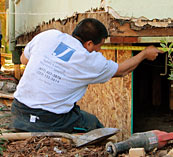How to Locate Interior Water Damage
Water can damage both the exterior and interior of a home. This includes moisture – small amounts of liquid spread out over an area, either in the atmosphere or on an object. When a water problem isn’t fixed, it can eventually lead to foundation problems and expensive foundation repairs.

Moisture can accumulate inside your home from any water source, including sinks, tubs, showers, toilets, plumbing and appliances. Also keep in mind that interior moisture problems can occur any time of the year. For example, in the winter, moisture will often get trapped inside a home by insulation, caulking and weather stripping.
One way to check for moisture issues is to inspect your walls. Any type of unusual surface discoloration, especially stains, can be an indicator of interior moisture. This includes dark spots, as well as mold and mildew. Mold has a black or green color, while mildew is usually grey or white. Both grow in moist environments and can cause severe health issues.
You may also have water issues if you find:
- Peeling paint
- Surface bubbles
- Cracking and crumbling
- Surface areas that have warped or buckled
- Soft or spongy areas on drywall
- Swelling along drywall edges and seams
Smelling your walls is another way to check for moisture. Mold and mildew will generally have an odor. Another indicator of interior moisture is foggy windows. Has the water pressure in your house decreased? A sudden drop in water pressure may mean a leak.
You can also check your home for moisture using a moisture meter. There are two basic types of moisture meters, pin and no pin. The pins in a pin meter are inserted into the wood. Meters without pins use a radio frequency to check for moisture.
Your foundation should be regularly (and thoroughly) inspected for water and moisture penetration as well. If you see any evidence of water damage in your basement, try to locate the source of the problem. You can also request an inspection from a foundation contractor, which is the best solution. Foundation contractors know what to look for and how to find the cause of the situation.
When water penetrates the soil around a foundation, it will expand. As the soil dries, it contracts, which can cause settlement. Water can also erode the soil around and under a foundation.
Another area of the house that should be checked is the attic. Look (and listen) for roof leaks, particularly during rainy periods. You should also be able to see water stains in places where the roof has leaked in the past.
When much moisture accumulates inside your home, it can cause wooden beams to rot. When support beams are weakened, they can eventually collapse.
How do you know if your home already has structural damage? Look for bowing walls, uneven floors, windows and doors that don’t close properly and wall cracks. These are all signs of possible structural problems. Also look at your roof from a distance to determine if there are any sags, curls or missing shingles.
Any kind of structure or foundation problem will become worse as time goes on. Regular foundation inspections and maintenance will prevent more serious damage for occurring.





